So, you want to visit the old town of Quebec, but you have a limited time frame? Don’t worry! It’s completely possible to visit it in just one day. My name is Amy, and I’m the cultural travel blogger behind templeseeker.com, and I’ve actually just got back from a wonderful 10 days in French Canada. I also had a limited amount of time in Quebec, because I was attending the TBEX (travel bloggers exchange) conference in Quebec City, and so I ultimately just had one day to see the old town.
The great news is that you will be able to see the majority of the old town in one day, including the armoury, the old city walls, the Notre-Dame de Québec Basilica-Cathedral and Chateau Frontenac. This is all doable on foot! If, like me, you love historical architecture, you will be pleased to hear that the old town of Quebec is UNESCO‑listed. And remember that Canada is one of the Top Solo Female Travel Destinations and a perfect choice for travelling alone for the first time.
Churches are free for tourists in Quebec!
One of the great things about Quebec is that all Churches are free! You won’t even find yourself paying to get in the Cathedral (like you will in Montreal). So if you see a church or chapel open, you are welcome to go inside and have a look, just remember to be respectful and many Churches ask for silence and no flash photography.
Should I do a guided walking tour of the Old Town of Quebec?
The best and easiest way to see the Old Town of Quebec is, of course, to join a walking tour. There are some great walking tours of the old town that include the main sites and churches/buildings. I recommend this grand walking tour of old town Quebec with Get your Guide. There are options to go as a group or to book a private tour. The advantage of this tour is that you will get a local guide who will be happy to share their knowledge of the history of the city, along with great recommendations on where to eat out – including the best Quebec poutine!
Do it yourself walking tour of Quebec old town
You don’t have to do a walking tour with a guide, it’s very easy to do it yourself. If you’ve got a lot of walking stamina, I recommend starting at the Joan of Arc garden and the plains of Abraham.
Joan of Arc Garden and the Plains of Abraham
The Joan of Arc Garden is a well kept garden that is of historical significance, as it’s the first place that ‘Oh Canada’, the national anthem was sung! Joan of Arc’s statue was unveiled in 1938. She is a national heroine of France, and her presence in Quebec—a former French colony—is deeply symbolic. The garden serves as a tribute to French roots, reinforcing Quebec’s distinct Francophone identity within Canada. Designed in the 1930s by Louis Perron, the Joan of Arc garden is a mix of French and English landscaping styles, showing a hybrid cultural aesthetic unique to Quebec.
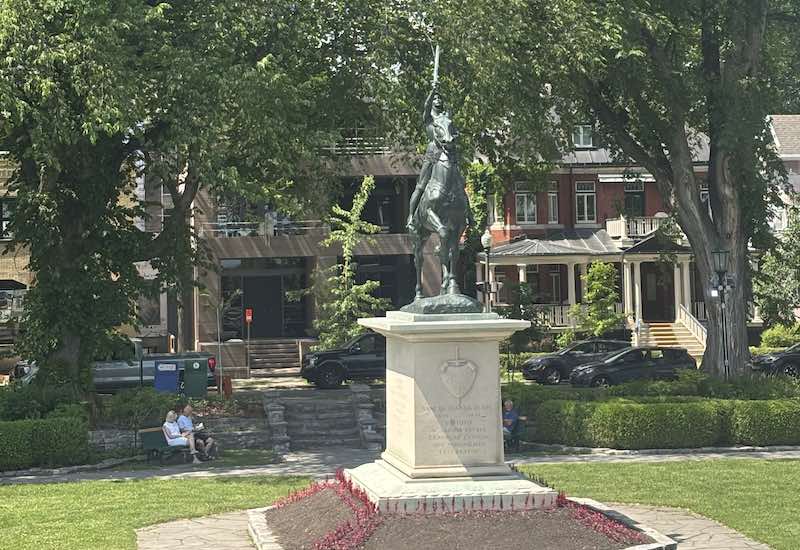
The Joan of Arc garden is located in the plains of Abraham – a historic battlefield central to Canadian history (Battle of Quebec, 1759). This area is particularly beautiful on a sunny day, as it’s the 10th largest urban park in the world.
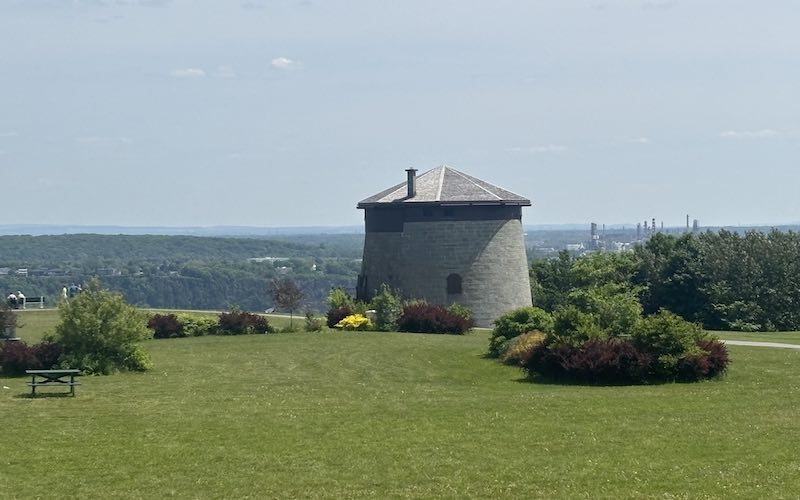
Grand Allée and the Armoury
From the Joan of Arc garden, join ‘Grand Allée’ – a beautiful tree lined street full of cafes, restaurants and hotels. You will pass the Voltigeurs de Québec Armoury (also known as the Grande‑Allée Armoury or Manège militaire) on the right, which is one of Quebec City’s most iconic heritage buildings. It was constructed between 1885 and 1888 in a distinctive Gothic Revival / Château style, featuring turrets, buttresses, and medieval-inspired elements. It served as the headquarters and drill hall for Les Voltigeurs de Québec, Canada’s oldest French-Canadian reserve infantry regiment, founded in 1862. Today it serves as a community and cultural hub, with a multipurpose hall for up to 1,300 guests.
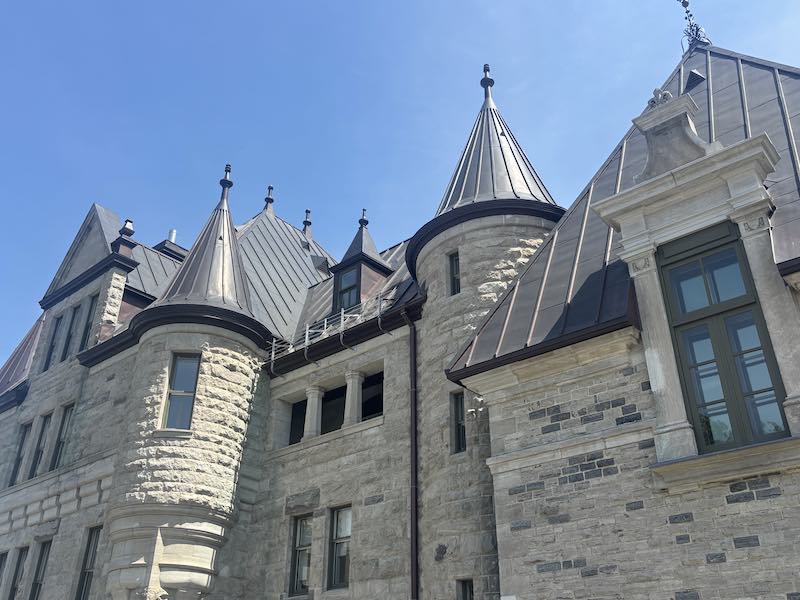
National Assembly and Fontaine de Tourny
The National Assembly of Quebec (Parliament Building), can be seen on the left hand side before you enter the Old Town of Quebec through St Louis Gate. It features the Fontaine de Tourny in front of it, one of the most beautiful fountains in Quebec. It was a gift from a Scotsman, and was inaugurated in 2007 to celebrate Quebec City’s 400th anniversary. I loved the frogs squirting water from their lily pads! Look closely, and you will see them too.
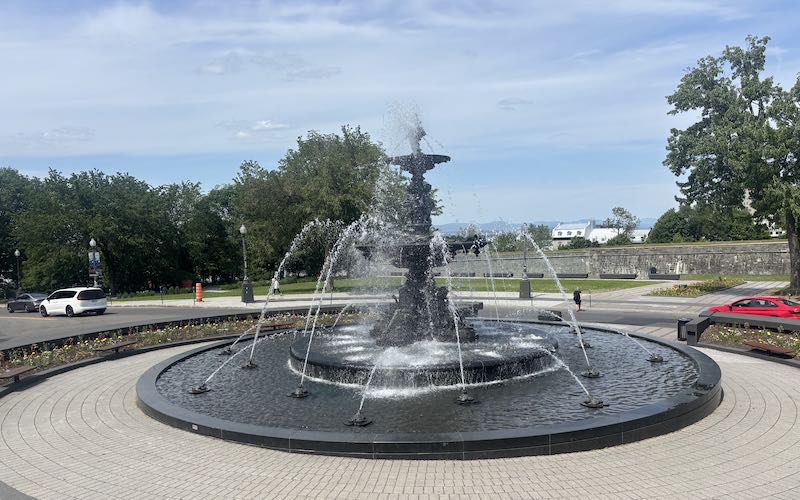
Entering the City walls at St Louis Gate
Entering the old town at St Louis gate, you will pass a Gandhi statue and a war memorial before you enter, and heads of Churchill and Roosevelt on the inside of the wall. The Old Town Walls of Québec City—also known as the ramparts—are more than a scenic boundary: they’re a living monument to the city’s 400+ year history and unique identity.
History sidenote: The first defensive palisades of Quebec appeared around 1690, in response to threats like the British attack on Port Royal. Rebuilt in stone by 1745 under French military engineer Gaspard-Joseph Chaussegros de Léry, the walls were expanded further west to accommodate city growth and fortify vulnerable access points. These ramparts played critical roles during major conflicts: they helped the British hold the city against French forces in 1760, and later withstood the American siege of 1775. Between 1820–1830, British engineers fortified and improved the defenses. Although many structures were later removed, the core ramparts and gates survived.
Place de Armes: Terasse Dufferin and Chateau Frontenac
You will walk down towards Terrasse Dufferin and admire the view of Chateau Frontenac. The chateau is one of the most famous and most photographed hotel in the world, with glorious views overlooking the St. Lawrence river. Built in 1892–93 by the Canadian Pacific Railway and designed by Bruce Price in the Châteauesque style, Chateau Frontenac features steeply pitched roofs, turrets and ornate gables. The chateau was home to French and English governors before it became hotel Fairmont.
If time allows, have a look underneath where you can see the original ruins beneath the Château Frontenac—known as the Saint‑Louis Forts and Châteaux National Historic Site. This museum style archeological site also contains historical artifacts, including tools, pottery, tiles, and household items from the original site of the chateau.
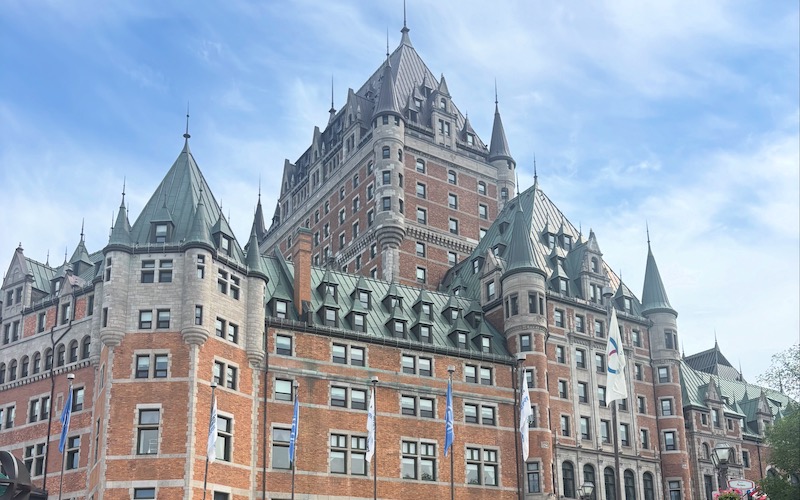
The Ursuline Monastery and Chapel of the Holy Trinity
Take a short detour to visit two important religious buildings: The Ursuline Monastery and Chapel of the Holy Trinity. The Ursuline Sisters have been in Quebec City since 1639. If you pass by the monastery and it’s open, you can visit their beautiful chapel. You can also visit the courtyard of the Chapel of the Holy Trinity, which was the first Anglican cathedral to be built outside of the British Isles.
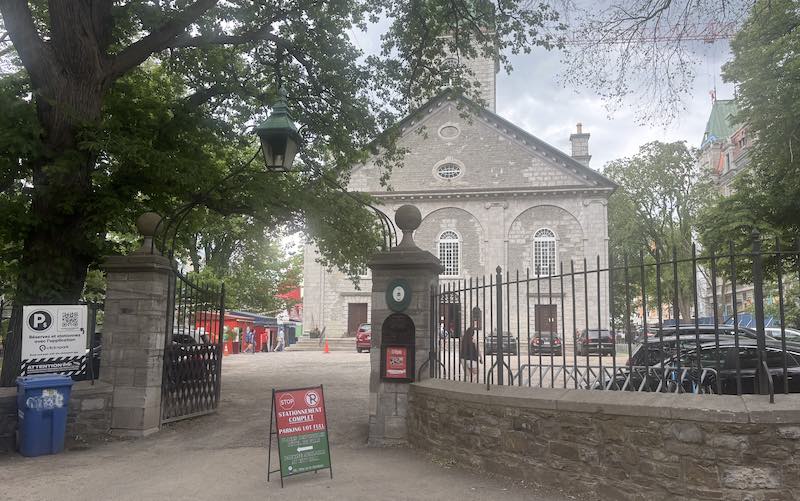
Notre-Dame de Québec Basilica-Cathedral
The next stop is the Notre-Dame de Québec Basilica-Cathedral, a Roman Catholic church originally built in 1647. It is the oldest parish church in North America north of Mexico. This beautiful Cathedral is the seat of the Archdiocese of Québec. The original building has been destroyed and rebuilt several times—most notably after fires in 1759 and 1922— but the current structure preserves much of its French colonial charm, with rich interiors, elaborate gilded decoration, and stunning stained glass. The Cathedral is home to the only Holy Door outside of Europe. The crypt houses the remains of Québec’s bishops and even the first Canadian-born saint, St. François de Laval. A statue of the fi
Also on this square is a beautiful all-year-round Christmas shop. So if, like my Aunty Deb, you are totally Christmas obsessed, pay this beautiful shop a visit and experience the magic of Christmas any time of year.
Quatier Petit Champlain
Next, don’t miss one fo the most beautiful streets in Quebec. Dating back to the 17th century, the ‘Petit Champlain’ street is the oldest commercial artery in North America. Quartier Petit Champlain boasts more than 47 unique and quirky shops and restaurants.
After your Old Town of Quebec walking tour eat your first Poutine!
You will be pretty damn tired after all of that, and so I recommend that you stop for your very first poutine. Poutine is a classic Québécois comfort food made of French fries, Cheese curds (fresh, squeaky white curds) and Gravy (a hot, brown, often slightly peppery sauce). When the hot gravy is poured over the fries and curds, the cheese softens slightly without fully melting, creating a rich, gooey, salty-savoury dish. Be warned – it’s very filling! I had a gorgeous poutine at La Buchette and ended up having to take half away with me!

All of the above is doable in just one day! So if you are wondering whether or not Quebec City is worth a quick weekend trip, it absolutely is!
When to travel to old town of Quebec
Early spring (May) and the start of Autumn/fall (September) are the best times to visit Quebec climate wise. The summer months of July and August can sometimes be too busy and too hot (with temperatures exceeding 30C). Avoid travelling to Quebec in the thick of winter because January and February frequently see over 40 inches of snowfall and temperatures below -10! However, it can be nice to visit in December for Christmas as long as you wrap up warm. Quebec is beautiful in the Christmas season. The snow usually sticks around until March.
You may also want to consider whether or not you want to time your visit with the many festivals that take place in Quebec, such as the Jazz festical (June) and Festival d’été de Québec (FEQ) in July.
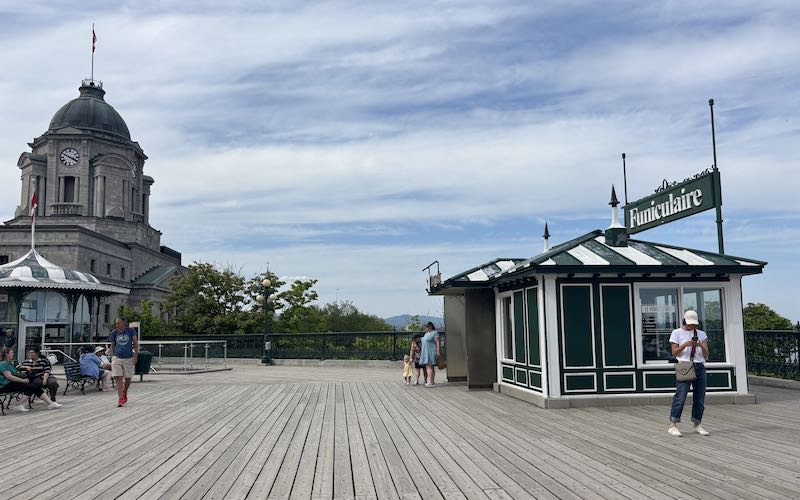
Tips for visiting the Old Town of Quebec
- Learn some basic French – although many locals can and do speak English, using some French will be beneficial.
- Bring credit and debit cards as well as Canadian dollars in cash – many restaurants and outlets in the old town are card only and don’t accept cash.
- Use the fernicular to get from the upper to the lower town with ease – it’s easier than using Escalier Casse-Cou (Breakneck Stairs).
- Take a sun hat and sun cream and cover your shoulders to avoid sunburn or heatstroke in the summer months (particularly June, July and August).
- Wear snow boots, lots of layers and a Goretex jacket in Quebec in the winter (December-February sees heavy snowfall).
- Take a refillable water bottle as there are plenty of places to fill up with free drinking water in the old town of Quebec.
I’ve plenty more to write about, having recently visited both Quebec City and Montreal, so please watch this space for more content on French Canada!

